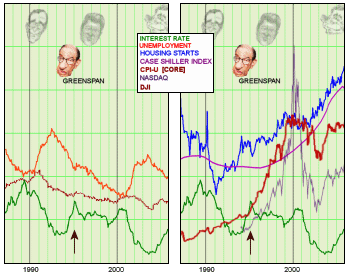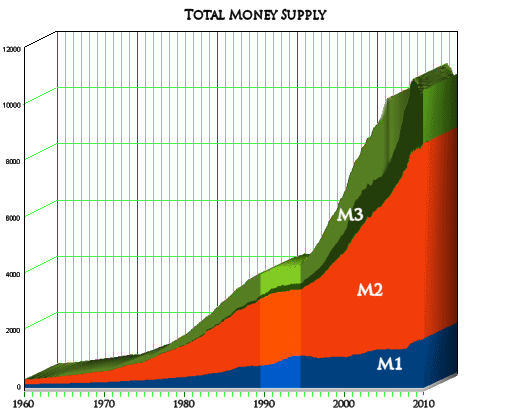What…
In 1995, Alan Greenspan did something dramatic. He kept Interest Rates low after a Recession for the next five years. The consequences have been covered endlessly here and elsewhere: A period of great prosperity that was illusory and came to an abrupt halt in September 2008 with The Great Recession.

The left chart shows the Interest Rates, Unemployment, and Inflation. The chart on the right shows the results – DOW, NASDAQ, Home Values, and Housing Starts. But the good times ended shortly thereafter. The question is, of course…
Why…
Why did Alan Greenspan do that? There wasn’t anything in the data shown to explain his action [and I’ve fried my brain trying to understand it]. It’s like he was trying to fix something. In nosing around trying to figure it out, I got to looking into Inflation/Deflation. While Core Inflation is usually estimated by the year-over-year CPI-U [minus food and energy], the strict definition is: "the consensus view is that a long sustained period of inflation is caused by money supply growing faster than the rate of economic growth" and vice versa. Since the CPI-U was not rising, Greenspan claimed there was no inflation. So I looked into the Money Supply. Such a can of worms. The Federal Reserve measures Money Supply in three parts: M1: readily available money M2: money accessible with penalty M3: sequestered money.
Here are the three parts over time [M3 is only complete through 2006, when they stopped compiling it except for the Institutional contribution]:

As you can see, there’s a dramatic flattening of the Money Supply in 1988/1989 that persists until around 1995 – the very time when Alan Greenspan opened the spigot with low interest rates. It didn’t show dramatically in the CPI-U [top left chart], but it’s striking in the Money Supply chart.
What happened in the late 1980’s to explain that? It seems clear that Greenspan’s gift of easy money reversed that trend [as I suspect it was intended to]. I was clueless, so I looked at the breakdown of the M1, M2, and M3 into their individual components [note the differing scales]:



M1 is just "ready cash" and doesn’t tell us much. But M2 and M3 are pretty clear, the flattening in the Money Supply has to do with the Thrifts [Savings and Loans]. "Of course!" thought 1boringoldman. What financial problem occurred in the end of the 1980’s? The Savings and Loan Crisis! My previous guesses were off the mark. In case you’ve forgotten the S&L Crisis:
| looking back – the Deregulation I… |
|
Depository Institutions Deregulation and Monetary Control Act of 1980: This legislation expanded the Federal Reserve’s rules to all Banks, and raised the level of FDIC coverage from $40,000 to $100,000. But it also began the Derugulation of Banking Institutions and the erosion of the Glass-Stegall Act:
Garn-St. Germain Depository Institutions Act of 1982: This Bill was passed to deregulate the Savings and Loans Industry. From the FDIC history:
"This Reagan Administration initiative is designed to complete the process of giving expanded powers to federally chartered S&Ls and enables them to diversify their activities with the view of increasing profits. Major provisions include: elimination of deposit interest rate ceilings; elimination of the previous statutory limit on loan to value ratio; and expansion of the asset powers of federal S&Ls by permitting up to 40% of assets in commercial mortgages, up to 30% of assets in consumer loans, up to 10% of assets in commercial loans, and up to 10% of assets in commercial leases."
Said then newly elected President Reagan on signing this Bill:
Thank you all very much, and thank you for joining us to sign this historic reform. This bill is the most important legislation for financial institutions in the last 50 years. It provides a long-term solution for troubled thrift institutions…
Now, this bill also represents the first step in our administration’s comprehensive program of financial deregulation… What this legislation does is expand the powers of thrift institutions by permitting the industry to make commercial loans and increase their consumer lending. It reduces their exposure to changes in the housing market and in interest rate levels. This in turn will make the thrift industry a stronger, more effective force in financing housing for millions of Americans in the years to come…
What followed wasn’t exactly what Reagan predicted. There was a rapid proliferation of Savings and Loans that had very imprudent lending practices, living outside the regulatory reach of conventional Banks. Within five years, there was a Savings and Loans Crisis:
The savings and loan crisis of the 1980s and 1990s (commonly referred to as the S&L crisis) was the failure of 747 savings and loan associations (S&Ls) in the United States. The ultimate cost of the crisis is estimated to have totaled around $160.1 billion, about $124.6 billion of which was directly paid for by the U.S. government—that is, the U.S. taxpayer, either directly or through charges on their savings and loan accounts—which contributed to the large budget deficits of the early 1990s. The concomitant slowdown in the finance industry and the real estate market may have been a contributing cause of the 1990–1991 economic recession. Between 1986 and 1991, the number of new homes constructed per year dropped from 1.8 million to 1 million, the lowest rate since World War II.
|
So there was a concrete Why for Alan Greenspan to keep the Interest Rates low in 1995 – to stimulate the economy and cover the impact of the massive failure of Reagan’s Deregulation agenda. In doing so, he directly set up the conditions for us to do it again! [this is called throwing good money after bad]. This time, it was on a far grander scale – the subprime mortgage/housing bubble/credit default swap debacle that dwarfed the S&L Crisis.
[…] mismanagement of the Fed Interest Rates that fueled the much larger Subprime Mortgage Crisis [the Why of Alan Greenspan’s destruction of our economy…] and the $1 trillion bailout of the "Banks too big to fail." But there was another piece […]
[…] and wiped out the savings and loan industry in 1990-1991." I reached the same conclusion from another direction. The second thing he did was mount a huge campaign against regulating Derivatives. I’ve […]